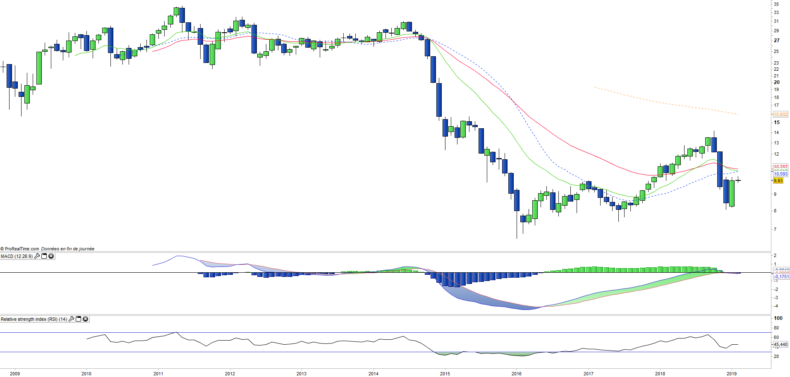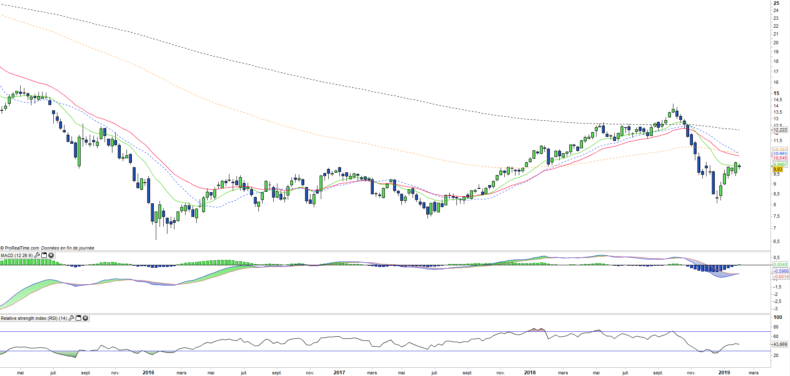Invesco Oil WTI - DBO - 06/02/19
Short Term strategy: Neutral (50%) / Trend +
Long Term strategy: Negative (5%) / Trend +
Characteristics of the ETF
The DBO ETF (Invesco-Powershares) created in 05/2007 replicates the crude oil prices through future contracts on light sweet crude oil (WTI).
The costs of the DBO ETF are 0.75% and AUM amount to approximately $322M. Oil is a very volatile asset, and as any commodity does not give rise to a dividend and is a risky asset.
Alternative ETFs: OLO (Deutsche Bank USD), BNO (US Commodity Fund USD).
Latest developments
WTI petroleum rose +4.9 in 2017 after a rebound of 9.2% in 2016 and turned down with a drop of 21.2% in 2018 after a spectacular fall of -23% in November and from 34% since the highs to $ 77 in early October.
The WTI oil rises sharply by 17% for now in 2019. The creeping coup in Venezuela supports the price of crude, because an internal conflict or provoked from the outside could slow down, even halt the current weak production of 1.5MBJ . Moreover, OPEC has said it is ready for further cuts in production if demand weakens while the minimum target is around $ 60. Another reason for the rebound is to look for reassuring news on the world economy, because of a possible agreement between the US and China and greater flexibility of central banks. Demand for oil is indeed a key variable for crude oil prices in 2019.
Index & components
Oil is a raw material that is a fossil fuel produced by a few countries like Saudi Arabia, the US, Russia, Iran, Iraq, Algeria or Nigeria.
It is extracted by drilling or hydraulic fracturing and is then delivered - processed / refined or not, in consumer countries, mainly European and Asian and can produce fuels such as gasoline, gas oil or kerosene once refined and processed chemically. Depending on its origin and final destination, oil has different names and its price may also vary. These differences in the price of oil depend on its quality. We differentiate the Arabian Light, which comes from the Middle East, the Brent oil that is produced in the North Sea, and finally the WTI or "West Texas Intermediate" which is produced in the United States and is the benchmark of the oil market.
The reference unit for oil is the barrel, which is actually about 159 liters. The price of a barrel of oil is quoted on the international market continuously, while two financial centers share its rating, namely New York for WTI and London for Brent.
Supply, therefore production and its stability are of course key determinants of the price of a barrel. It is OPEC, made up of several major world producing countries, which is in charge of determining - by consensus - how many barrels a day will be produced and its publications are therefore followed with attention by traders, as was the case recently.
Demand factors are also critical. Thus, an increase in the energy needs of a major consumer country may have a greater or lesser influence on the price of the barrel. Globally, global growth is a very important factor for demand, while oil needs tend to shrink at equal demand, as new technologies tend to reduce consumption. In the long term, the electric car could cause a negative shock on global demand for crude oil, as China is investing heavily in renewable energy.
Since 2014, oil prices have divided by 3 due to a supply shock caused by the arrival on the market of American shale oil which has put very strong pressure on the oil-producing and oil companies that have significantly reduced their investments. This stoppage of industrial investment, in addition to OPEC's production cuts, has for the moment had a moderate bullish impact on crude prices. This is due to the plethoric production of unconventional oil (shale) that floods the market and counterbalances OPEC's reduction efforts.
Monthly data
On the weekly chart, we see the rebound attempt that is close to the moment of truth. The pivotal line of the trend is determined by the area where the EMAS 20,13 and 26 intersect at around $ 10.7 which is the main objective of this rebound. Only a confirmed overtaking of this area would trigger a turning upwards.
Weekly data
The weekly chart shows a strong rebound in progress but which is a pause on the resistance formed by the EMA13. Positive signals are in progress on the oscillators, with the positive reversal of the MACD which could soon be followed by the momentum indicator. However, the pivot point for restoring the mid-term uptrend is around $ 10.7, where stand the EMAS 20, 26 and 100 periods.
Theme
DBO is an ETF which seeks to replicate the level of the DBIQ Optimum Yield Crude Oil Index Excess Return (DBIQ Opt Yield Crude Oil Index ER)
Characteristics
| Inception date | 01/05/2007 |
| Expense ratio | 0,78% |
| Issuer | Invesco |
| Benchmark | DBIQ Opt Yield Crude Oil Index |
| code/ticker | DBO |
| ISIN | US73936B5075 |
| Currency | $ |
| Exchange | NYSE |
| Assets Under Management | 316 M$ |
| Dividend | No |
| Currency Risk | No |
| Number of holdings | NS |
| Risk | 4/5 |
Country Breakdown
| USA | 100% |
Sector Breakdown
| Oil WTI | 100% |
Principales composantes
| Oil WTI | 100% |


